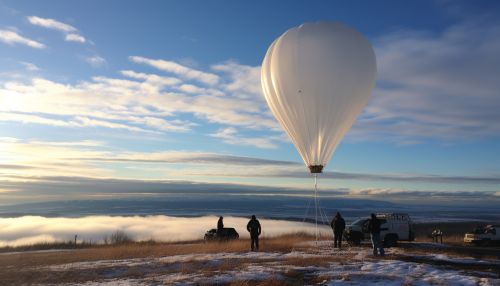Weather Balloon
Introduction
A weather balloon, also known as a sounding balloon or radiosonde, is a balloon specifically designed to carry instruments aloft to send back information on atmospheric pressure, temperature, humidity and wind speed by means of a small, expendable measuring device called a radiosonde. To obtain wind data, they can be tracked by radar, radio direction finding, or navigation systems (such as the satellite-based Global Positioning System, GPS).


History
The first consistent flights of weather balloons began in the 19th century with the purpose of aiding weather forecasting. French meteorologist Léon Teisserenc de Bort is credited with the invention of the weather balloon in 1896. His work paved the way for further study of the Earth's atmosphere, particularly the stratosphere.
Design and Operation
Weather balloons are made of latex or synthetic rubber (neoprene) and filled with either helium or hydrogen. They can ascend at a rate of 300 meters (1,000 feet) per minute and reach altitudes of 20-30 kilometers (12-19 miles) before bursting. A small parachute then brings the radiosonde back to Earth, where it can be refurbished and reused.
Radiosonde
A radiosonde is a battery-powered telemetry instrument package carried into the atmosphere usually by a weather balloon. It measures various atmospheric parameters and transmits them by radio to a ground receiver. Modern radiosondes measure or calculate the following parameters: altitude, pressure, temperature, relative humidity, wind (both wind speed and wind direction), cosmic ray readings at high altitude and geographical position (latitude/longitude).
Launch and Recovery
Weather balloons are launched at over 800 locations worldwide twice daily. The launch requires a crew of two or three people and takes about 30 minutes. The balloon is filled with gas until it has a diameter of about 1.5 meters (5 feet). The radiosonde is then attached to the balloon, and both are released into the wind. The balloon ascends at a rate determined by the size of the balloon and the weight of the radiosonde.
Applications
Weather balloons are primarily used in meteorology as a way to obtain a vertical profile of the atmosphere's pressure, temperature, and humidity. They can provide a detailed picture of the atmosphere at a single point in time. The data they collect is used in weather forecasting, climate research, and for research and planning in industries such as agriculture, forestry, and oil and gas extraction.
